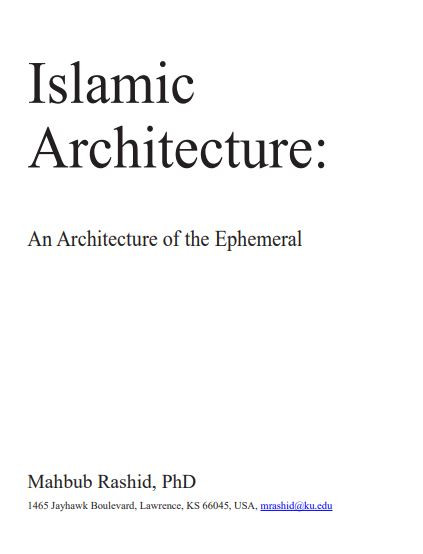
Written as an introduction to the Architecture of the Muslim world, this paper discusses the underlying similarities of different regional architectural styles developed by Muslims over a vast geographical area during a period between the late seventh century and the early twentieth century. After briefly describing regional variations, the paper describes the basic building types, both religious and non-religious, that Muslims built in different regions. Among the important building types briefly described are mosques, tombs, caravansary, and urban dwellings. Following this, the paper describes gardens built by Muslims and their design principles and symbolism. An important feature of architecture and landscape architecture of the Muslim World, gardens represented the Qur’ānic promise of a heavenly garden in paradise as a reward for faith and purity. With water and trees, these gardens created places of respite and calmness in mostly hot arid zones of the Muslim world. After gardens, the paper describes the guiding principles of decorations in the architecture of the Muslim world. Rich in their symbolism, decorations were among the most important unifying aspects of architecture and fine arts in the Muslim world. They were often used for imparting a sense of impermanence to the material world, and for providing a visual demonstration of the infinite extensiveness of Allah. The paper also describes the basic elements of decorations in art and architecture, which include calligraphy, architectonic elements, vegetal elements and arabesque, human and animal figures, color, light and geometry. After decorations, the paper describes the underlying principles of the architecture of the Muslim world. Often used unconsciously, these principles helped establish a connection between the symbolic aspects and the formal aspects of the architecture of the Muslim world. They include a perpetual relationship between the sacred and the secular, a search for harmony between verticality and horizontality, a search for unity in the interior, and a search for expressiveness on the exterior. Finally, the paper describes many unifying forces, such as religion, language, and migration, which might have helped produce the hidden similarities underneath the apparent differences seen in the architecture of the Muslim world.
Rashid, Mahbub. “Islamic Architecture: An Architecture of the Ephemeral.” (2020).
I agree to the terms outlined below:
You agree to upload and assign Mosqpedia Database the rights to use the content worldwide and in perpetuity across all current and future media platforms. Mosqpedia Database may edit, copy, adapt and translate your contribution.
The content will be distributed under the Creative Commons Attribution-Deed – Attribution-NonCommercial-NoDerivatives 4.0 International – Creative Commons
All data will be stored in line with data protection regulations.